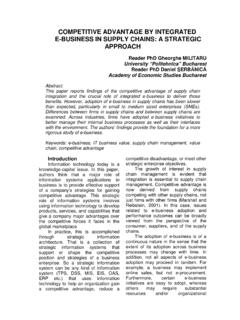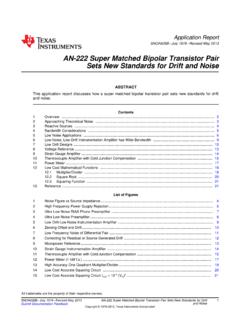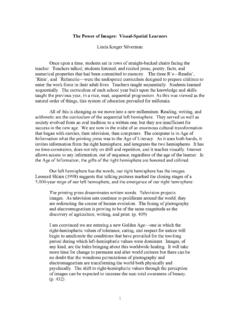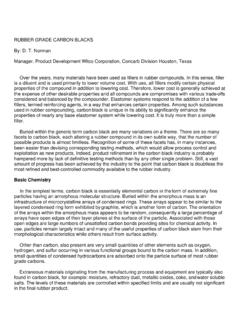Transcription of UNDERSTANDING CUSTOMERS - PROFILING AND …
1 UNDERSTANDING CUSTOMERS - PROFILING AND segmentation Mircea Andrei SCRIDON Babes Bolyai University of Cluj-Napoca Abstract: In any industry, the first step to finding and creating profitable CUSTOMERS is determining what drives profitability. This leads to better prospecting and more successful customer relationship management. Any company can segment and profile their customer base to uncover those profit drivers using the knowledge of their CUSTOMERS , products, and markets. Or they can use data-driven techniques to find natural clusters in their customer or prospect base. Whatever the method, the process will lead to knowledge and UNDERSTANDING that is critical to maintaining a competitive edge.
2 Key words: PROFILING , segmentation , penetration analysis, cluster analysis. The methodologies discussed in this paper describe several techniques and applications for UNDERSTANDING CUSTOMERS . Common sense tells us that it is a good first step to successful customer relationship management. It is also an important step for effective prospecting. In other words, once companies know what customer attributes and behaviors are currently driving their profitability, they can use these to direct their prospecting efforts as well. The first step in effective prospecting is learning how to find prospects that look like CUSTOMERS for the company. It is also useful to segment and profile the prospect base to assist acquisition efforts.
3 The goal in both cases is to identify what drives customer profitability. The second half of the paper details the process using a case study. The study is from the household industry, in which it will show some profile and penetration analyses. Next, it will illustrate the use of cluster analysis to discover segments. What is the importance of UNDERSTANDING CUSTOMERS ? Studies show that many companies operate for years pumping out offers for products and services without a clue of what their best customer looks like. For every company in every industry, this is the most important first step to profitable marketing. Similar to modeling, before a company begins any PROFILING or segmentation project, it is important to establish their objective.
4 This is crucial because it will affect the way in which to approach the task. The objective can be explained by reviewing the definitions of PROFILING and segmentation . PROFILING is exactly what it implies: the act of using data to describe or profile a group of CUSTOMERS or prospects. It can be performed on an entire database or distinct sections of the database. The distinct sections are known as segments. Typically they are mutually exclusive, which means no one can be a member of more than one segment. segmentation is the act of splitting a database into distinct sections or segments. There are two basic approaches to segmentation : market driven and data driven.
5 Market-driven approaches allow managers to use characteristics that they determine to be important drivers of their business. In other words, they preselect the characteristics that define the segments. This is why defining the objective is so critical. The ultimate plans for using the segments will determine the best method for creating them. On the other hand, data-driven approaches use techniques such as cluster analysis or factor analysis to find homogenous groups. This might be useful if companies are working with data about which they have little knowledge. Types of PROFILING and segmentation If a company have never done any segmentation or modeling, its customer base may seem like a big blob that behaves a certain way, depending on the latest stimulus.
6 If the company does a little digging, it will find a variety of demographic and psychographic characteristics as well as a multitude of buying behaviors, risk patterns, and levels of profitability among the members of its database. This is the beauty of segmentation and PROFILING . Once companies understand the distinct groups within the database, they can use this knowledge for product development, customer service customization, media and channel selection, and targeting selection. RFM: Recency, Frequency, Monetary Value One of the most common types of PROFILING originated in the catalog industry. Commonly called RFM, it is a method of segmenting CUSTOMERS on their buying behavior.
7 Its use is primarily for improving the efficiency of marketing efforts to existing CUSTOMERS . It is a very powerful tool that involves little more than creating segments from the three groups. Recency. This value is the number of months since the last purchase. It is typically the most powerful of the three characteristics for predicting response to a subsequent offer. This seems quite logical. It says that if a consumer has recently purchased something from a company, it is more likely to make another purchase than someone who did not recently make a purchase. Frequency. This value is the number of purchases. It can be the total of purchases within a specific time frame or include all purchases.
8 This characteristic is second to recency in predictive power for response. Again, it is quite intuitive as to why it relates to future purchases. Monetary value. This value is the total currency amount. Similar to frequency, it can be within a specific time frame or include all purchases. Of the three, this characteristic is the least powerful when it comes to predicting response. But when used in combination, it can add another dimension of UNDERSTANDING . These three characteristics can be used alone or in combination with other characteristics to assist in CRM efforts. Demographic The emphasis is on finding the individual who may not fit the local demographic profile.
9 In reality, though, many people who live in the same area behave in a similar fashion. There are many sources of demographic data. Many sources are collected at the individual level with enhancements from the demographics of the surrounding geographic area. Segmenting by values such as age, gender, income, and marital status can assist in product development, creative design, and targeting. There are several methods for using demographics to segment a database and/or build customer profiles. Life Stage With few exceptions, our lives follow patterns that change over time to meet our needs. These patterns are clustered into groups defined by demographics like age, gender, marital status, and presence of children to form life stage segments.
10 Life stage segments are typically broken into 176 young singles; couples or families; middle-aged singles, couples, or families; and older singles or couples. Additional enhancements can be achieved by overlaying financial, behavioral, and psychographic data to create well-defined homogeneous segments. UNDERSTANDING these segments provides opportunities for businesses to develop relevant products and fine-tune their marketing strategies. The market segments should pass the following rules in order to be taken into consideration: They should be relevant to the business objective They should be understandable and easy to characterize They should be large enough to warrant a special offering They should be easy to develop unique offerings After testing which of the segments have passed the above rules, a company should evaluate the results behaviorally and financially to determine which segmentations and offerings should be expanded to the target population, and also how good did they perform against the business objectives, set by it.











